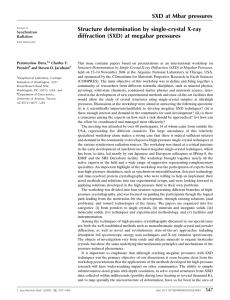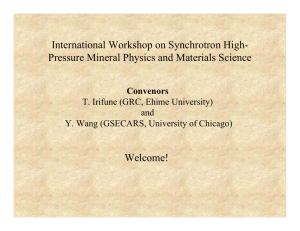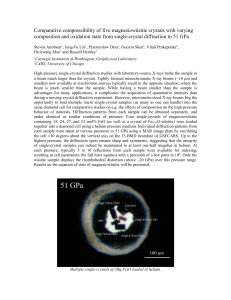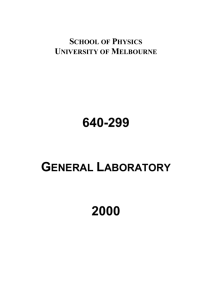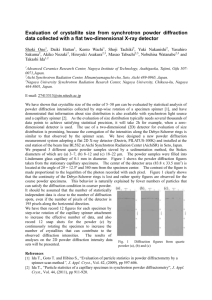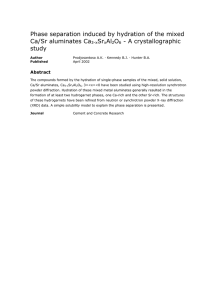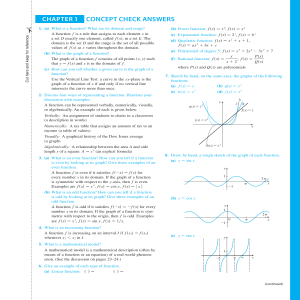New synchrotron - based single crystal
advertisement
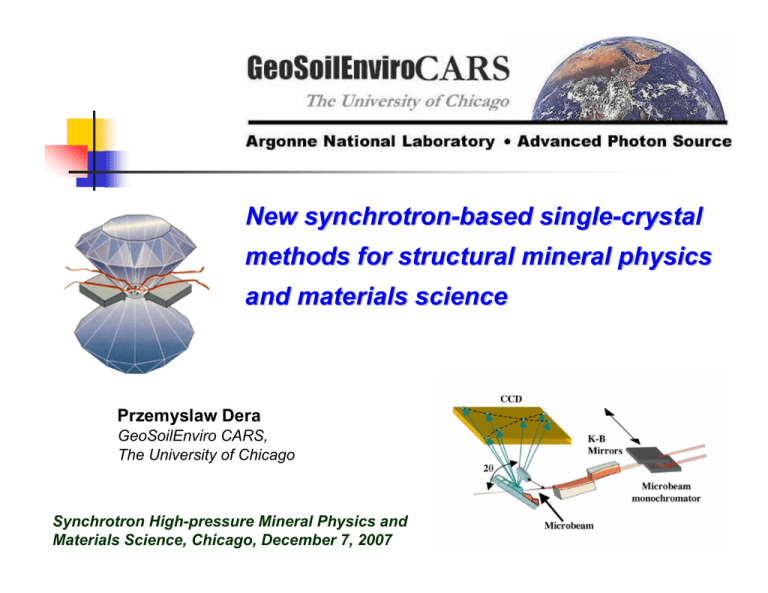
New synchrotron-based single-crystal methods for structural mineral physics and materials science Przemyslaw Dera GeoSoilEnviro CARS, The University of Chicago Synchrotron High-pressure Mineral Physics and Materials Science, Chicago, December 7, 2007 High pressure crystallography Status Quo SXD high-pressure studies are very infrequent, compared to high-pressure powder XRD because of: Lack of dedicated/optimized facilities Lack of dedicated/custom software More challenging sample preparation “Fear or sophistication” In USA there currently are no synchrotron facilities offering routine high-pressure SXD capabilities SXD experiments, if performed provide a very detailed information about the structural changes at high pressure Because of lack of optimized experimental methodology high-pressure SXD studies have been limited to much lower pressure than powder diffraction experiments Needs, desires and motivation Many phase transitions identified using powder diffraction, or with spectroscopic methods, for which there are no models of high-pressure phases. Powder diffraction HP experiments are becoming routine to perform, even in the megabar pressure range. There is little that can be significantly improved. The detailed structural information is very hard to retrieve from powder diffraction data, due to 1-dimensional character of the data and peak overlapping and ambiguous indexing. SXD can take full advantage of lower intensity synchrotron beamlines (BM) Super-small beam size is not critical SXD data collection can be as fast as PXD SXD allows for a much better control of hydrostaticity SXD allows to work with multi-phase/crystal assemblages SXD decouples the phase transitions form grain size effects, grain-boundary interactions etc. SXD carries much more information content and much more detailed information What is an SXD experiment Diffraction experiment performed with sample that contains one or more single-crystal grains with size of >0.001mm Data collection involves measurement of directions and intensities of individual diffracted beams and corresponding crystal orientations for a large population of reciprocal space vectors. Reciprocal space is reconstructed in three dimensions, allowing for unambiguous indexing Measured peak intensities are free from spatial and energy overlaps GOAL 1: make mSXD possible at any monochromatic high-pressure synchrotron station equipped with area detector and rotation stage (instrument control and data analysis) GOAL 2: Create custom (hardware and software) SXD solutions optimized for high-pressure experiments Alternative solutions mSXD with point detector Simple data analysis Accurate unite cell, and intensities Low background due to diffracted beam collimation Long data collection time Very user-involving during early data collection stages Extensive sample rotation needed Real diffractometer needed mSXD with area detector Simple data analysis, but presence of DAC complicates it Very fast data collection Higher redundancy of data Sample rotation needed “Global picture” available immediately Can be done with very simple rotation stage mSXD with area detector Center the sample on rotation axis and with the beam Collect diffraction images while rotating the sample Determine detector coordinates and sample orientations for each diffraction peak Reconstruct the reciprocal space in 3-d Determine the orientation matrix (index) Predict peak positions in recorded diffraction images and retrieve peak intensities (structure factor amplitudes) Solve/refine the structure vmSXD with area detector 1. 2. 3. Ice, Dera et al. J. Synchr. Rad. (2005) Scan the sample with white beam to find the most promising grain (Laue) Perform series of monochromatic exposures at varied energies that cover whole or part of the incident spectrum Assign peak energies using appearance and disappearance of peaks Challenge: The method was designed to study strain in known phases, requires knowledge of the unit cell vmSXD with area detector: reciprocal space reconstruction MRI project scope Budget of ~$0.8M for three years Two synchrotrons, three beamlines APS (GSECARS + HPCAT), ALS (CALYPSO) Three main techniques mSXD, vmSXD, pSXD New hardware (dedicated goniometers, area detectors) Customized and uniform software (IDL, EPICS) For more information, please visit: http://rruff.geo.arizona.edu/OLA/files/SXD.htm MRI project at GSECARS: 13BMD BM, wide energy range (5-60 keV), KB microfocusing (0.005x0.015) MAR345 (MAR165 CCD) detector on a translation stage Resistive heating capabilities On line Brillouin and Raman Spectroscopy mSXD and vmSXD capabilities Rotation scan and energy scan data collection strategies MRI project at GSECARS: 13IDD ID, energy range (15-40 keV), KB microfocusing (0.005x0.008mm) YAG and CO2 on-line laser heating systems MAR165 CCD (MAR345) detector and sub-second exposures Rotation scan and energy scan data collection strategies MRI project at GSECARS: 13BMC • 6-circle kappa geometry • All axes have DC-servo motors with speeds up to 16 degrees/second, allowing on-the-fly scanning. Pilatus Newport 6-circle Fixed-energy monochromatic beam at 10, 15 and 30 keV The expected focal spot size 0.025x0.025 mm. Super fast PILATUS detector (200 Hz data collection capabilities) 13IDD, 5 GPa, Unit cell edge 56 A Hydrostaticity issue: •Gas loading (in commissioning) •Laser annealing (available) 13BMD, 40 GPa, 0.01x0.01x0.003mm crystal Summary SXD method is a very powerful technique that can be used to reveal details of even very complicated crystal structures at high pressure, complementary and usually superior to powder diffraction. SXD can provide much more precise information for EOS studies (S. Jacobsen) The data collection process can be as simple as that of powder experiments. All of GSECARS experimental stations offer now SXD capabilities. At GSECARS SXD can be combined with heating (laser or resistive) and on-line spectroscopy (Brillouin and Raman) Acknowledgements MRI postdocs L. Borkowski B. Lavina HPCAT: G. Shen, P. Liermann, W..Yang MRI grant M. Nicol R.T.Downs GSECARS: M. Rivers W. Prakapenka P. Eng S. Ghose COMPRES NSF DMR MRI program
